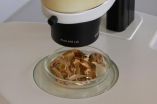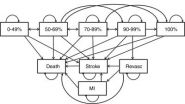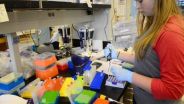(Press-News.org) Overindulging in high-calorie snacks is partly caused by lapses in a very specific part of the brain, according to a new University of Waterloo study.
The study, published in Psychosomatic Medicine: Journal of Biobehavioral Medicine, is the first to conclusively link reduced operation of the dorsolateral prefrontal cortex with self-restraint in the dietary context.
"It has long been thought that the dorsolateral prefrontal cortex helps to keep automatic, or knee-jerk, reactions in check," said Professor Peter Hall, senior author on the study. "We discovered that when you temporarily dampen the operation of this particular part of the brain, strongly engrained—and quite universal—preferences for high calorie foods start to hijack people's thought patterns and even their eating patterns."
The prefrontal cortex is known to be implicated in the brain's executive functions, which typically allow people to engage in voluntary control over their behavior. While prior studies have shown that boosting activity in the prefrontal cortex reduces cravings for unhealthy foods, this is the first study to show that reducing activity leads to more cravings and food consumption.
The study used continuous theta burst stimulation, a form of transcranial magnetic stimulation, to temporarily reduce activity in participants' left dorsolateral cortex. After receiving theta burst stimulation, participants not only reported greater food cravings for calorie-dense food, but ate more junk food during a taste test than when they received a bogus stimulation.
"This is the first study to demonstrate that taking the prefrontal cortex temporarily offline results in increased snacking," said Cassandra Lowe, doctoral student in the School of Public Health and Health Systems and lead author on the paper.
The findings will provide a theoretical framework to help shape effective public health interventions, with a focus on preservation of brain health.
"The research suggests that the best solution to effective self-restraint lies in maximizing brain health. Interventions aimed at enhancing or preserving dorsolateral cortex function in healthy populations may reduce the likelihood of obesity and other chronic conditions," said Hall.
Engaging in aerobic exercise, avoiding alcohol and getting enough sleep are proven methods of maximizing the strength of the prefrontal cortex.
"In the end, if you want to improve your self-control when it comes to snacking, structuring your environment to avoid temptations is crucial; but beyond this, the key is to keep your brain in shape, so that you are up to the task when you encounter temptations. Let's face it, they are everywhere," said Hall.
INFORMATION:
Caving to cravings? Indulging in junk food linked to lapses in brain function
2014-09-16
ELSE PRESS RELEASES FROM THIS DATE:
Powerful synergies across different sectors improve health of poor women and children
2014-09-16
New studies have uncovered the specific interventions and advances that have led to the success with these at-risk populations in the poorest countries.
New research across 142 countries finds that some 50 percent of the reduction in under-five child mortality in those countries is attributable to high impact health interventions such as early immunizations and skilled birth attendance.
The remaining 50 percent is due to factors outside the health sector, such as girls' education, women's participation in politics and the workforce, reduction of fertility rates, access ...
A new therapeutic target may prevent blindness in premature babies at risk of retinopathy
2014-09-16
This news release is available in French. According to a study conducted by pediatricians and researchers at Sainte-Justine University Hospital Research Center (Sainte-Justine) and Université de Montréal published online in the prestigious medical journal Nature Medicine on September 14, 2014, the activation of a receptor that migrates to the nucleus of nerve cells in the retina promotes the growth of blood vessels. The finding opens the possibility of developing new, more selective drugs to control the abnormal growth of blood vessels and prevent blindness including ...
What's for dinner? Rapidly identifying undescribed species in a commercial fungi packet
2014-09-16
For lovers of wild foods, autumn harks a season of bounty. Fungi of dizzying variety erupt from wood and soil, luring intrepid collectors to woodlands in search of elusive but delectable wild mushrooms. Part of their appeal lies in the allure of the treasure hunt, and their mysterious not-quite-meat, not-quite-vegetable qualities that belie an almost otherworldly existence. But are the mushrooms which you are eating known to science?
The Fungi Kingdom is enormously diverse yet vastly underdocumented – although some estimates range up to 10 million species, only about ...
Imaging identifies asymptomatic people at risk for stroke
2014-09-16
OAK BROOK, Ill. – Imaging can be a cost-effective way to identify people at risk for stroke who might benefit from aggressive intervention, according to a new modeling study published online in the journal Radiology.
The study looked at people with asymptomatic carotid artery stenosis, a narrowing of the major blood vessels supplying blood to the head due to atherosclerosis, or plaque buildup. Carotid artery stenosis is the primary cause of up to 20 percent of ischemic strokes, which result from an obstruction within a blood vessel and make up 85 percent of all strokes. ...
Researchers debunk myth about Parkinson's disease
2014-09-16
Using advanced computer models, neuroscience researchers at the University of Copenhagen have gained new knowledge about the complex processes that cause Parkinson's disease. The findings have recently been published in the prestigious Journal of Neuroscience.
The defining symptoms of Parkinson's disease are slow movements, muscular stiffness and shaking. There is currently no cure for the condition, so it is essential to conduct innovative research with the potential to shed some light on this terrible disruption to the central nervous system. Using advanced computer ...
Dental and nutrition experts call for radical rethink on free sugars intake
2014-09-16
Sugars in the diet should make up no more than 3% of total energy intake to reduce the significant financial and social burdens of tooth decay, finds new research from UCL (University College London) and the London School of Hygiene & Tropical Medicine.
The study, published in the open-access journal BMC Public Health, analysed the effect of sugars on dental caries, also known as tooth decay. They show that sugars are the only cause of tooth decay in children and adults.
Free sugars are defined by the World Health Organisation Nutrition Guidance Adivisory Group as follows: ...
Collaboration drives achievement in protein structure research
2014-09-15
When this week's print issue of the journal Science comes out, a collective cheer will go up from New Mexico, Montana and even the Netherlands, thanks to the type of collaborative effort that is more and more the norm in these connected times. Yes, the research was brilliant, and if we're lucky, it will produce innovations in biology, medicine, biotechnology and agriculture. It could save lives, and it happened because this scientist talked with that one, that one knew another one, and brilliant minds overcame geographic distance to advance human understanding.
"It is ...
Certain form of baldness at age 45 linked to higher risk of aggressive prostate cancer
2014-09-15
A new, large cohort analysis from the prospective Prostate, Lung, Colorectal and Ovarian (PLCO) Cancer Screening Trial, indicates that men who had moderate baldness affecting both the front and the crown of their head at age 45 were at a 40% increased risk of developing aggressive prostate cancer (usually indicates a faster growing tumor resulting in poorer prognosis relative to non-aggressive prostate cancer) later in life, compared to men with no baldness. There was no significant link between other patterns of baldness and prostate cancer risk. The study, published September ...
Researcher develops and proves effectiveness of new drug for spinal muscular atrophy
2014-09-15
COLUMBIA, Mo. – According to recent studies, approximately one out of every 40 individuals in the United States is a carrier of the gene responsible for spinal muscular atrophy (SMA), a neurodegenerative disease that causes muscles to weaken over time. Now, researchers at the University of Missouri have made a recent breakthrough with the development of a new compound found to be highly effective in animal models of the disease. In April, a patent was filed for the compound for use in SMA.
"The strategy our lab is using to fight SMA is to 'repress the repressor,'" said ...
EEG study findings reveal how fear is processed in the brain
2014-09-15
DALLAS, TX – September 12, 2014 - An estimated 8% of Americans will suffer from post traumatic stress disorder (PTSD) at some point during their lifetime. Brought on by an overwhelming or stressful event or events, PTSD is the result of altered chemistry and physiology of the brain. Understanding how threat is processed in a normal brain versus one altered by PTSD is essential to developing effective interventions.
New research from the Center for BrainHealth at The University of Texas at Dallas published online today in Brain and Cognition illustrates how fear arises ...



